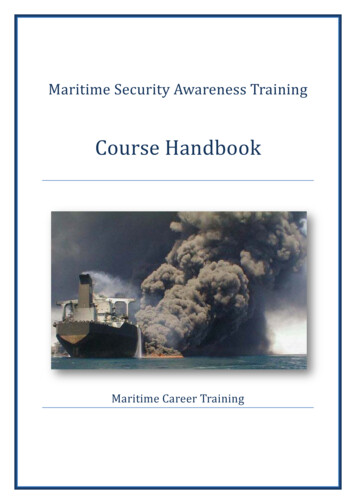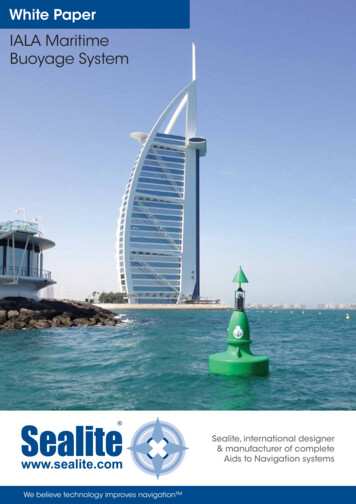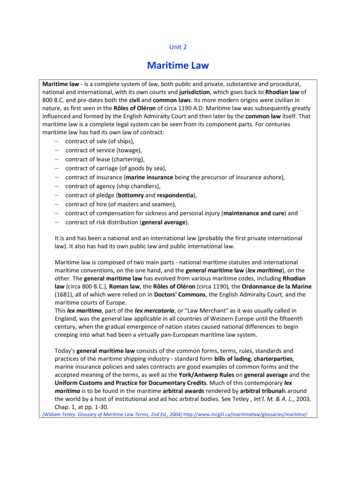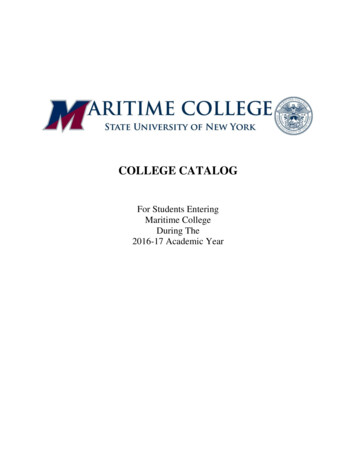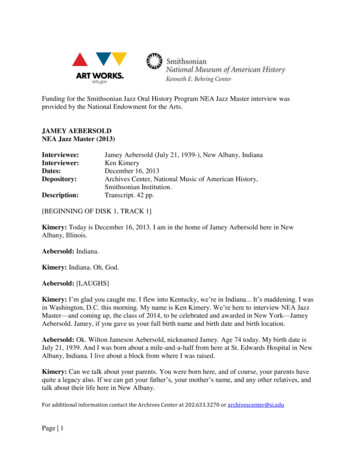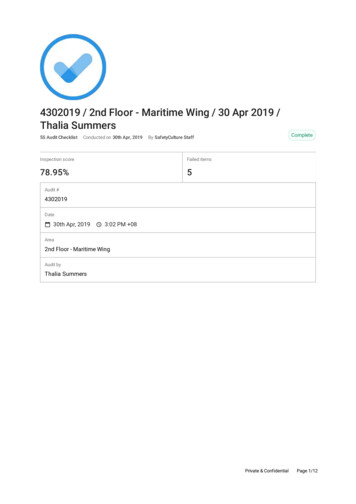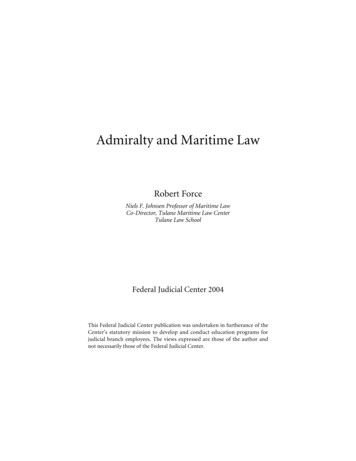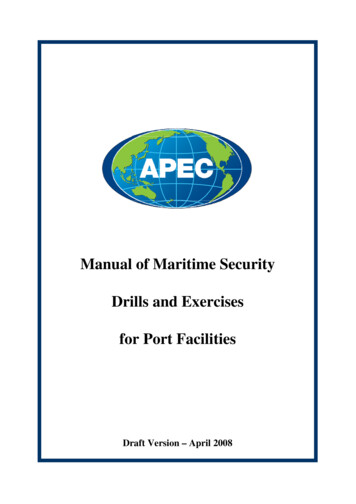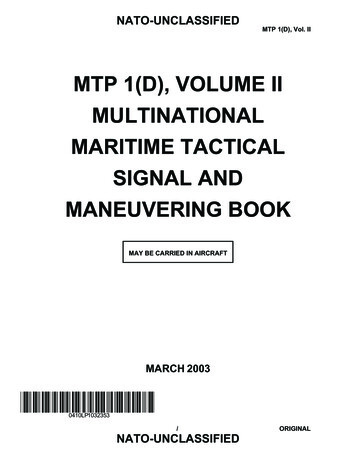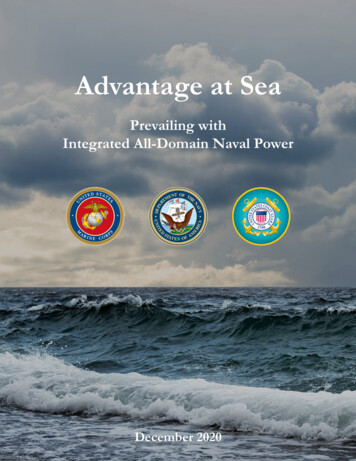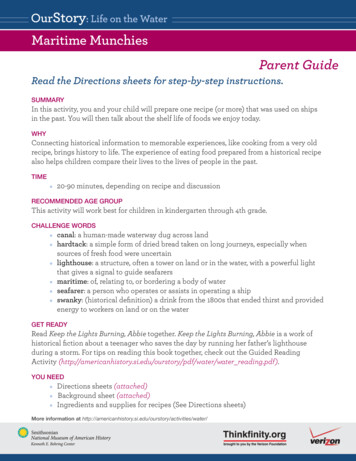
Transcription
OurStory: Life on the WaterMaritime MunchiesParent GuideRead the Directions sheets for step-by-step instructions.SUMMARYIn this activity, you and your child will prepare one recipe (or more) that was used on shipsin the past. You will then talk about the shelf life of foods we enjoy today.WHYConnecting historical information to memorable experiences, like cooking from a very oldrecipe, brings history to life. The experience of eating food prepared from a historical recipealso helps children compare their lives to the lives of people in the past.TIME 20-90 minutes, depending on recipe and discussionRECOMMENDED AGE GROUPThis activity will work best for children in kindergarten through 4th grade.CHALLENGE WORDS canal: a human-made waterway dug across landhardtack: a simple form of dried bread taken on long journeys, especially whensources of fresh food were uncertainlighthouse: a structure, often a tower on land or in the water, with a powerful lightthat gives a signal to guide seafarersmaritime: of, relating to, or bordering a body of waterseafarer: a person who operates or assists in operating a shipswanky: (historical definition) a drink from the 1800s that ended thirst and providedenergy to workers on land or on the waterGET READYRead Keep the Lights Burning, Abbie together. Keep the Lights Burning, Abbie is a work ofhistorical fiction about a teenager who saves the day by running her father’s lighthouseduring a storm. For tips on reading this book together, check out the Guided ReadingActivity water reading.pdf).YOU NEED Directions sheets (attached)Background sheet (attached)Ingredients and supplies for recipes (See Directions sheets)More information at water/
OurStory: Life on the WaterMaritime MunchiesBackground InformationFor more information, visit the National Museum of American History Web ies/water/.For hundreds of years, seacoasts, rivers, lakes, and canals havehad a big impact on the ways America has changed as acountry. Even Americans who have never seen an ocean are stillvery connected to water. Eating fish for dinner, playing at thebeach, ordering goods made overseas, and other maritimeactivities continue to play an important role in our lives.Life and work on the water—for seafarers, fishers, passengers, andmany others—have included many big challenges and successes,and even some disasters. On shore, many other jobs areconnected to maritime activities, like moving cargo carried byboats, making fishing nets, and running lighthouses.Schooner Cook’s BellThis brass bell was usedsummon the crew to mealsAlthough many of America’s waters are sources of food, the foodon a fishing schooner in thelate 1800s.that comes onboard with seafarers is very important. Today, wehave refrigerators and freezers to help keep our food fresh and safeto eat for a long time. But in the past, people living inlonely places (like some lighthouses) and traveling onboats to faraway places had to pack foods that wouldlast a long time.For more information, visit the On the Water onlineexhibition at http://americanhistory.si.edu/onthewater.Image of Matinicus Rock Lighthousein Maine.Unknown dateWhat are your favorite foods? How do youkeep them fresh? How long would it take forthem to go bad?Cook a batch of food that would last a long time while out at sea or in afar-off lighthouse in the 1800s!
OurStory: Life on the WaterMaritime MunchiesDirections, page 1 of 4For adults and kids to follow together.HardtackHardtack was a simple kind of bread that could still be eaten for a long time after itwas baked. The ingredients are very simple and do not become stale or moldy likeregular bread. This hardtack will be fresh, since it will be fresh from the oven. Afterbeing stored for days or weeks, it becomes hard. Some sailors ate hardtack bysoftening it in soup or breaking it into small enough pieces that they could tuck intheir mouths to suck on.INGREDIENTS 4 cups flour (white, whole wheat,or mixed)2 cups water4 teaspoons saltTOOLS OvenKnife or pizza cutterCookie sheetSpatulaSpoonToothpick or forkMeasuring Cups1. Preheat oven to 375 F.2. Mix flour and salt together in a bowl.3. Add just enough water (less than two cups) to make the mixture stick together. Itshould not be sticky at this point.4. Use your hands to roll the dough until it is ½–inch thick and shape it into a roughrectangle.5. Cut the dough into squares about 3 inches by 3 inches to form individual crackers.6. Use a toothpick or one point of a fork to press (but don’t punch through) 4 rows of4 holes on each cracker. (A total of 16 holes per square.)7. Place crackers on an ungreased cookie sheet.8. Bake crackers for 30 minutes.9. Turn each cracker over and bake for another 30 minutes. The crackers should beslightly brown on each side.
OurStory: Life on the WaterMaritime MunchiesDirections, page 2 of 4Hardtack (continued)Think About It! How do you think these would taste after sitting in a wooden barrel for a week? Amonth?What ingredients could you add to the hardtack to add some flavor? Make surethe ingredients wouldn’t rot on a long trip!What food(s) do we have today that are like hardtack?Take some of your hardtack and store it in a tin box or wrapped in a paper towel.After leaving it out for a week, try it again. How has it changed over a week?
OurStory: Life on the WaterMaritime MunchiesDirections, page 3 of 4For adults and kids to follow together.SwankySwanky was used in the 1800s for thirsty workers, like the crew of a ship or theharvesters on a farm. Think of it like the sports drink of the past—it can keep you frombeing thirsty and give you a bit of energy (through the sugar).INGREDIENTS 5 cups water1/2 cup molasses1/4 cup vinegar3 teaspoons ground gingerTOOLS Measuring cupsDrinking cupsBowl or clean bucketSpoonSimply mix the ingredients together. You may want to add more water (up to 10 cupstotal).Think About It! Following the original recipe, what did you think of the taste?Did you add more water? Why might the recipe have called for less water? (Hint:There were limited quantities of fresh water on board. Drinking ocean water canmake you very sick, so you would never have mixed it into a drink.)Does it taste like the sports drinks we have today?
OurStory: Life on the WaterMaritime MunchiesDirections, page 4 of 4General Discussion Questions If you were going to go on a trip for a week, what foods would you want to pack?Would any of those foods need to keep cold? Where would you get the energy torun the refrigerator or the ice to keep it chilly?What kinds of technology help you protect your food today? If you lived in thepast, how would you keep foods from rotting, going sour, or attracting bugs andanimals? Plastic is a relatively new invention. In the past, you couldn’t just wrapyour sandwich in plastic wrap or put your food in a plastic box. What other wayscould you use to protect your food?On long trips, the boat would have to pack food for everyone on board and eachperson only got a specific amount of each food. Congress even made a law to saywhat the minimum amount of food per sailor was! For example, in the early 1800s,the U.S. Navy packed the following food for one sailor for one day:One pound of meatHalf a pound of rice or flourFourteen ounces of bread (once slice of bread weighs about one ounce)Two ounces of sugar (about ¼ cup)One ounce of coffee or cocoa or a quarter of an ounce of teaHalf a cup of “spirits” (Water was hard to keep fresh on long voyages, so sailorswere given rum or other alcoholic beverages to drink)Who cooks your food every day? Do you decide what you get to eat, or doessomeone else set the menu? Many boats had cooks on board to make the food forthe sailors. Here’s a sample menu for the week:Sunday: beef, potatoes, bread, flour, and rumMonday: beef, potatoes, breadTuesday: pork, beans, breadWednesday: fish, potatoes, bread, rumThursday: beef, rice, breadFriday: pork, beans, breadSaturday: fish, potatoes, bread, rum
OurStory: Life on the WaterMaritime MunchiesTeacher Guide, page 1 of 3Read the Directions sheets for step-by-step instructions.SUMMARYStudents will cook one or more historical maritime recipes. They will then compare thefoods they eat to what was served on ships in the past.RATIONALEThrough directly encountering some recipes connected to maritime history in the19th-century, children will gain a deeper, more memorable connection to the relatedhistorical content. This experience will also serve as the springboard for comparing the pastand present and the impact of technology on lives in the past and present. Memorableexperiences that are connected to academic subjects, like history, will encourage curiosityand interest, helping children to become lifelong learners.OBJECTIVESThe students will be better able to: Follow recipes/instructions.Name one or more food eaten onboard ships in the past.TIME 20–90 minutes, depending on recipe and discussionAGE GROUP: K–4TARGET VOCABULARY: canal: a human-made waterway dug across landhardtack: a simple form of dried bread taken on long journeys, especially whensources of fresh food were uncertainlighthouse: a structure, often a tower on land or in the water, with a powerful lightthat gives a signal to guide seafarersmaritime: of, relating to, or bordering a body of waterseafarer: a person who operates or assists in operating a shipswanky: (historical definition) a drink from the 1800s that ended thirst and providedenergy to workers on land or on the waterMore information at water/
OurStory: Life on the WaterMaritime MunchiesTeacher Guide,page 2 of 3MATERIALS Directions sheets (attached)Background sheet (attached)Ingredients and tools vary by recipe (see Directions sheets)SUMMARYRead Keep the Lights Burning, Abbie together. Keep the Lights Burning, Abbie is a work ofhistorical fiction about a teenager who saves the day by running her father’s lighthouseduring a storm. For active reading strategies to go with this book, check out the GuidedReading Activity water reading.pdf).STUDENT PERFORMANCE CRITERIA Follow directions.Name specific dish(es) made.STANDARDSNCHS History StandardsK-4 Historical Thinking Standards1G. Explain change and continuity over time.3H. Explain causes in analyzing historical actions.K-4 Historical Content Standards7A. The student understands the cultures and historical developments of selectedsocieties in such places as Africa, the Americas, Asia, and Europe.8A. The student understands the development of technological innovations, the majorscientists and inventors associated with them and their social and economic effects.IRA/NCTE Language Arts Standards1.Students read a wide range of print and non-print texts to build an understanding oftexts, of themselves, and of the cultures of the United States and the world; toacquire new information; to respond to the needs and demands of society and theworkplace; and for personal fulfillment. Among these texts are fiction andnonfiction, classic and contemporary works.
OurStory: Life on the WaterMaritime MunchiesTeacher Guide,21st-Century SkillsLearning and Innovation Skills Critical Thinking and Problem Solvingpage 3 of 3
canal: a human-made waterway dug across land hardtack: a simple form of dried bread taken on long journeys, especially when sources of fresh food were uncertain lighthouse: a structure, often a tower on land or in the water, with a powerful light that gives a signal to guide seafarers maritime: of, relating to, or bordering a body .
